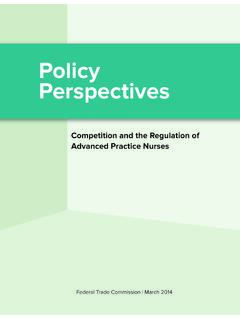Transcription of Coming into effect February 1, 2021 under the ... - Alberta
1 Changes in child careComing into effect February 1, 2021 under the new Early Learning and Child Care Act and Regulation February 2021 Changes in child care | February 20212 Parents and families across Alberta rely on child care providers every day to support the growth and development of their children. Licensed child care providers and certified early childhood educators help children build skills that support their growth and overall health. Child care providers play an essential role in Alberta s economy. When parents and caregivers go to work or school, they need to know their children are safe and are provided with the resources they need to grow and thrive.
2 The new legislation and regulations will give operators and educators the tools and flexibility to do what they do best, meet the needs of families in their communities. The Early Learning and Child Care Act and Regulation improve the standard for quality and safety in licensed programs, provide more information and transparency for parents and caregivers, streamline and modernize licensing processes, and give licensed providers more time to support children. These changes are based on feedback from over 10,000 Albertans who participated in the first child care consultation since 2008, as well as feedback received from the sector over the last decade.
3 We ve worked with child care operators and educators to improve the standard of care for children and create a more modern and flexible approach to child care programs. For operators, this means less time on paperwork and more time with kids and families. And for parents and caregivers, it means peace of mind. Rebecca Schulz, Minister of Children s Services Changes in child care | February 20213 Quality in child careThe updated Act embeds principles of quality and matters to be considered into the law, which means that licensed child care programs must reflect these in their operations and daily The Early Learning and Child Care Act identifies the following three principles to guide its interpretation and application in all areas relating to the licensing of child care programs.
4 The safety, security, well being and development of the child is to be supported and in child care supports choice and accessibility for of parents and community members in the provision of child care supports the child s optimal in child care | February 20214 Matters to be considered by providers of child care programsThe Act gives direction on a number of matters that must be taken into consideration by providers of child care programs and operationalized in the program plan:(a) children should be encouraged in having care and play experiences that support their development and learning;(b) the child is to be protected from all forms of physical punishment, physical and verbal abuse and emotional deprivation; (c) diversity in (i) the background and circumstances of children in the program and their families, including those who may be experiencing social or economic vulnerability, and (ii) the abilities of the children in the program is to be respected and valued.
5 (d) the child s familial and Indigenous or other cultural, social, linguistic and spiritual heritage are central to the child s safety, well being and development;(e) care of the child must be appropriate to the child s mental, emotional, spiritual and physical needs and stage of development;(f) involvement and engagement of parents supports accountability of child care program providers, monitoring of child care programs and maintenance of good quality child care in child careChanges in child care | February 20215 Simplifying child care licensingPrevious Child Care Licensing ActFive types of child care:If you were licensed or approved under the previous Act and Regulation, you now fall into one of two categories: licensed facility or home-based program.
6 Facility-based licences include daycares, preschools and out-of-school care programs. Licensed home-based programs will include family day home program educators operating under licensed family day home agencies. Group family care and innovative child care will no longer be categories under the new Act. Existing programs in these categories will carry on indefinitely under the CCLA and will not be Early Learning and Child Care Act Two types of child care:preschool home-based (overseen by a licensed family day home agency)daycare group family child care innovative child careout-of-school carefacility-basedChanges in child care | February 20216 Ratios for daycare programs will change slightly for older children.
7 Previously, there was a specified staff-to-child ratio for age ranges years (1:8 ratio); and years and older (1:10 ratio). under the new Regulation, there will be new categories for age range 3 years to less than 4 years (1:8 ratio); and 4 years and older (1:10 ratio). This will allow greater flexibility for daycare programs to operate, while maintaining the safety of younger and out-of-school care programs are now able to mix children of different age groups (older than 19 months) throughout the day. The staff-to-child ratio is calculated based on the age of the majority of the ratios under the ELCC ActDaycare programs Staff-to-child ratiosAge of childPrimary staff-to-child ratioMax number of children per groupInfants less than 12 months1:36 Infants 12 months to less than 19 months1:4819 months to less than 3 years1:6123 years to less than 4 years1:8164 years and older1:1020 Blue denotes that mixed-age groups are permitted throughout the day between the hours of 8:30 and 4.
8 30 Ratios for mixed-age groups should be determined based on the age of the majority of children in the group. Daycare programs during rest periods Staff-to-child ratiosAge of childPrimary staff-to-child ratioInfants less than 12 months1:6 Infants 12 months to less than 19 months1:819 months to less than 3 years1:123 years to less than 4 years1:164 years and older1:20 Rest period means any period when a child is lying down, including on or in a mat, bed, crib, cradle or bassinet, for the purpose of sleeping or resting. Changes in child care | February 20217 Preschool programs Staff-to-child ratiosAge of childPrimary staff-to-child ratio19 months to less than 3 years1:63 years and older1:12 Parent volunteers will be allowed to act as staff members in the staff-to-child ratios will be streamlined to provide clarity for operators.
9 Previously, there was a staff-to-child ratio for kindergarten-aged children (1:10 ratio), and another for children grade 1 and older (1:15 ratio). The proposed amendment will create one ratio for kindergarten and older (1:15 ratio). The maximum group size will be 30 care programs Staff-to-child ratiosAge of childPrimary staff-to-child ratioMax number of children per groupKindergarten children and school-aged children1:1530 Blue denotes that mixed-age groups are permitted throughout the day between the hours of 8:30 and 4:30 Ratios for mixed-age groups should be determined based on the age of the majority of children in the group.
10 Changes in child care | February 20218 More flexibility for licensed providersThe Early Learning and Child Care Act and Regulation gives licensed providers more flexibility with:Mixed-age groupsDaycares and out-of-school care programs are now able to mix children of different age groups (older than 19 months) throughout the day. The staff-to-child ratio is calculated based on the majority age of the in-ratioProgram supervisors are now permitted to be included in the staff to child ratio in times of need (when opening or when an early childhood educator is sick).Access to outdoor spacesDaycares can now request an exemption to access public outdoor spaces such as parks, trails, fields, or other areas that are within safe walking distance from the building.










